Cat lovers know that a clean litter tray is the key to a cat’s happiness – plus it also means less stress for us humans! But let’s be honest: cleaning your cat’s litter tray isn’t one of your favourite daily tasks, is it? And yet it’s so important to clean the tray not only regularly, but also thoroughly to keep bacteria and unpleasant odours at bay. Don’t worry though, it doesn’t have to be complicated! With a few simple tricks, keeping your cat’s litter tray clean can be a breeze! And your furry feline friend will thank you for it! Curious? Read on to find out how to manage the task quickly and effortlessly:
How often should you clean your cat’s litter tray?
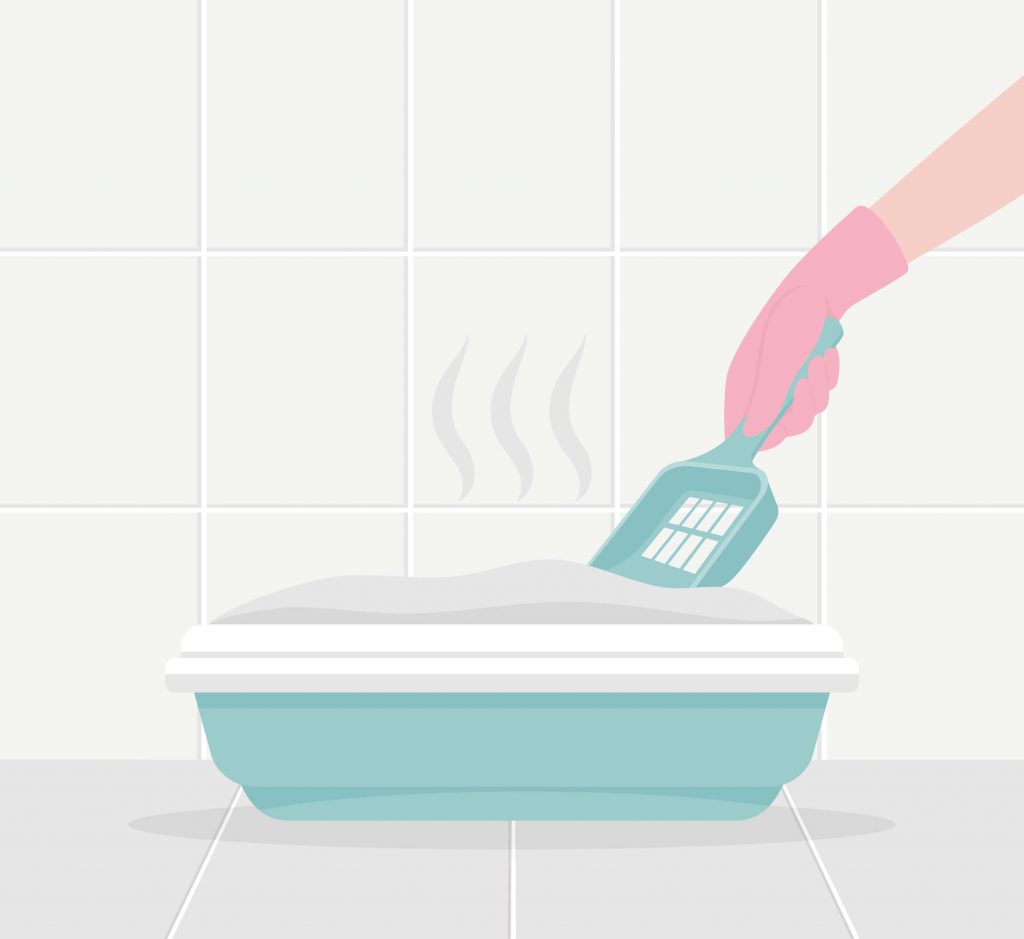
Very few tasks are more important for the happy coexistence of cats and their human owners than keeping the litter tray clean. But how often do you have to actually clean the tray for it to be enough? All cats love a fresh litter tray, so it’s best to tend to it daily, just to make sure your cat feels completely comfortable. Imagine having to use a toilet that hasn’t been cleaned for days … not a pleasant thought, is it? That’s exactly how your cat feels when you neglect their litter tray. But don’t worry; that’s easy to change! When you clean the litter tray on a regular basis, it prevents unpleasant odours and guarantees it will always stay fresh and clean – a virtual oasis of well-being!
Clean your cat’s litter tray daily
When you clean your cat’s litter tray every day, you’re not just keeping it clean; you’re also keeping it bacteria-free, which is an essential part of caring for your cat – and for yourself. Bacteria are particularly fond of warm and moist environments, which is exactly what they find in the litter tray! It’s the perfect breeding ground for many different types of bacteria, which means that when you clean the litter on a daily basis, you’re preventing microbes from multiplying unhindered. This is important, because bacteria multiply quickly! ¹
¹ Source: VAAM (Vereinigung für Allgemeine und Angewandte Mikrobiologie) 2024: “Wie schnell vermehren sich Bakterien?”, online atWie schnell vermehren sich Bakterien? / VAAM – Vereinigung für Allgemeine und Angewandte Mikrobiologie e.V., accessed on 7 Oct. 2024
DID YOU KNOW…
… that under optimal conditions bacteria can multiply in a very short time? Some types of bacteria, such as “Escherichia coli”, divide and multiply every 20 minutes. Others, such as “Clostridium perfringens”, can even double in 9 minutes. This means that a single bacterial cell can produce up to 280 billion offspring in a single day! In a litter tray, where moisture and warmth prevail, these are almost ideal conditions for rapid bacterial growth.
Cat litter trays mainly contain bacteria associated with cat faeces. These bacteria include the following:
- “Salmonella”: these bacteria can be excreted in cat faeces, especially if the cat eats raw meat.
- “Toxoplasma gondii”: a small parasite found in cat faeces that can cause toxoplasmosis.
- “Escherichia coli” can also occur, but these bacteria are more important for general hygiene than specifically for litter trays.
- “Streptococcus and Staphylococcus-related” bacteria can also be found in the litter tray; they make their way there either via the cat’s body or through contact with faeces.
All of these types of bacteria thrive particularly well in environments that are moist and warm.
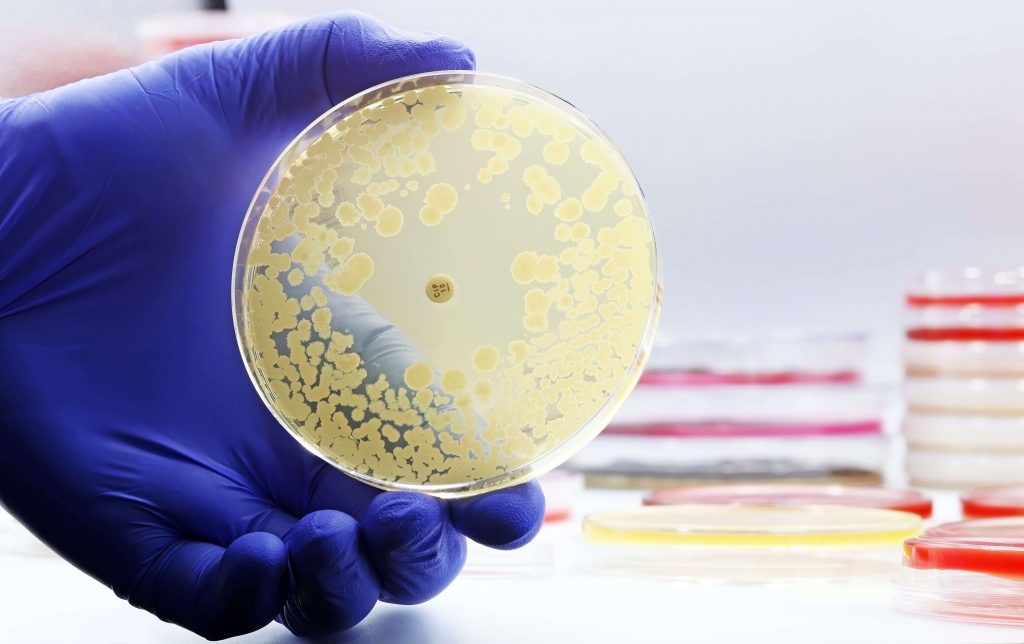
PLEASE NOTE:
PLEASE NOTE:
Cat litter trays are the perfect breeding ground for germs!
This is why it’s essential for all cat-loving homes to practice good litter-tray hygiene; not only does it prevent odours, it also provides reliable protection against diseases and infections.
When choosing a cat litter, you should always look for one that has high absorbency and optimum fluid retention, both of which will help prevent bacteria from multiplying!
How can the bacteria in your cat’s litter tray impact your health – and the health of your cat?
- 1. Your health:
A number of scientific articles have been published on the types of bacteria found in cat litter trays and their possible impact on human and feline health. These bacteria include “Escherichia coli” and “Salmonella”, both of which can enter the environment via contact with faeces and potentially be harmful to our health. Cat faeces can also transmit the parasite known as “Toxoplasma gondii”, which causes toxoplasmosis. One study on toxoplasmosis² indicates that cats can excrete millions of spores of this parasite every day. This can increase the risks for human beings, especially in the case of pregnant women and people who are immunocompromised.
² Source: bdw+ bild der Wissenschaft (9 July 2013): „Infektionsgefahr aus dem Katzenkot“, online at Infektions-Gefahr aus dem Katzenkot – wissenschaft.de, accessed on 7 Oct. 2024
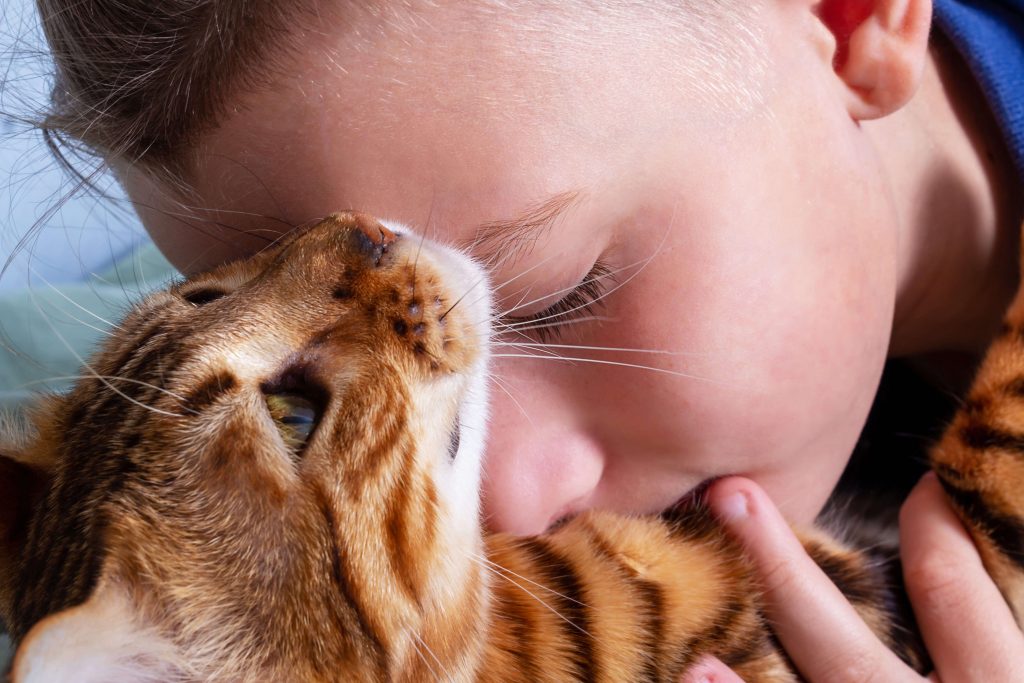
- 2. The health of your cat:
Poor litter tray hygiene can impact your cat’s health and lead to kidney, bladder and urinary tract infections, e.g. bacterial cystitis. Bacterial cystitis in cats ³ can have various causes. In most cases, the bacteria enter the bladder via the urethra and cause unpleasant symptoms. If your cat has a weakened immune system or anatomical problems, these factors can also play a role. An unhygienic litter tray will harbour many more harmful bacteria than a clean tray, and these bacteria can make their way into the cat’s genital area; this is why it’s essential that you keep your cat’s litter tray clean, as it will significantly reduce the risk of infection.
³ Source: fellomed (29 Jan. 2018): “Bakterielle Blasenetzündung bei Katze”, online at Bakterielle Blasenentzündung (Zystitis) bei der Katze (fellomed.de), accessed on 7 Oct. 2024
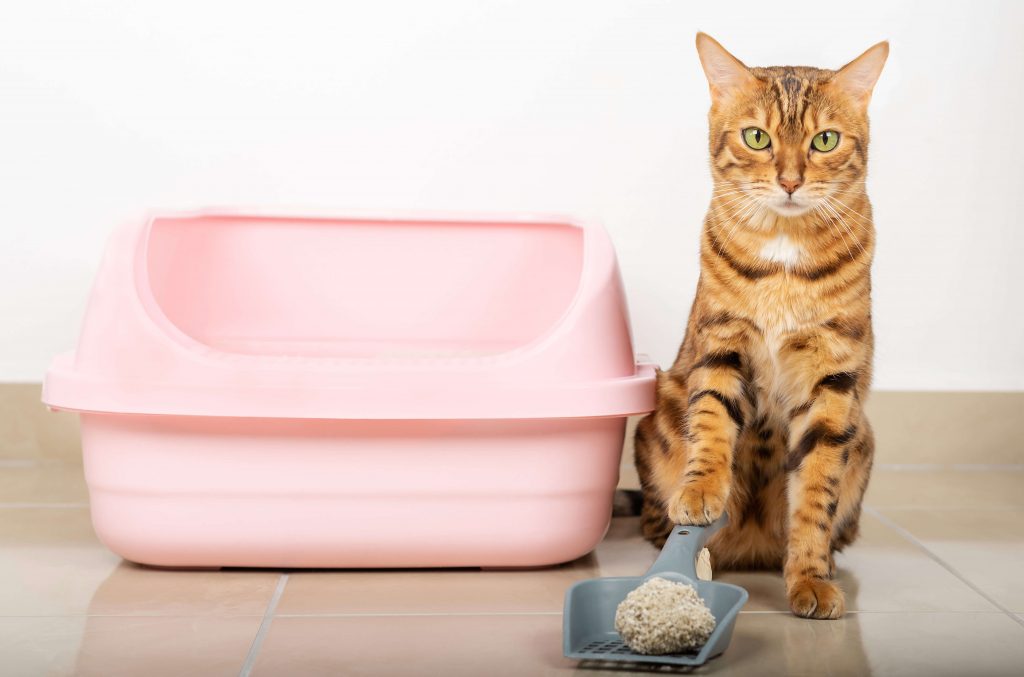
DON’T FORGET:
Remove urine and faeces from your cat’s litter tray at least twice a day!
Weekly cleaning of the litter tray
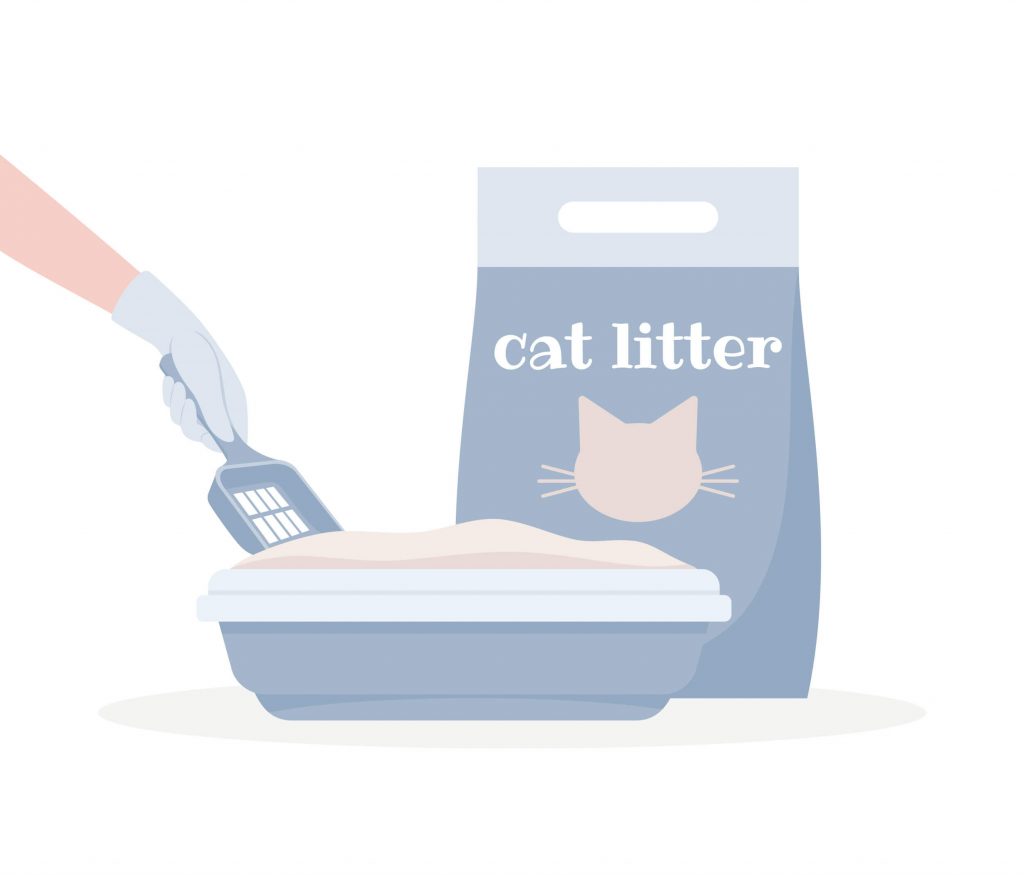
It’s important that you remove faeces from your cat’s litter tray every day, but you should also clean the whole litter tray thoroughly once a week. To do this, remove the litter and wash out the tray with warm water and a mild detergent. Cats have a sensitive nose, so you should avoid aggressive chemicals! By cleaning the entire tray once a week, you can prevent bacteria from settling and unpleasant odours from forming. After cleaning, refill the tray straight away using any clean leftover litter or a full tray of fresh litter.
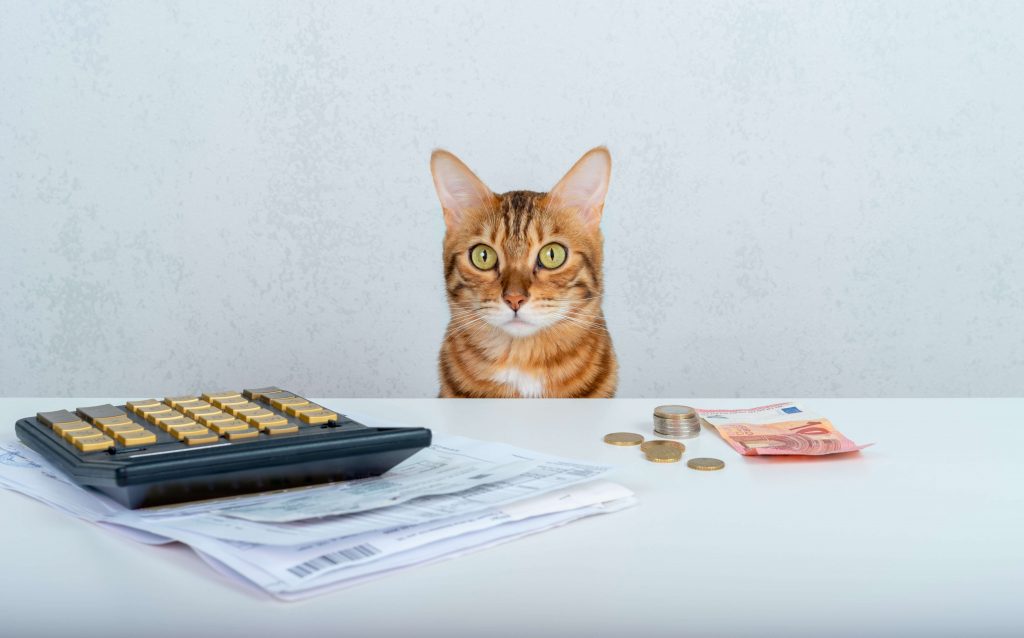
TIP:
Use a high-quality, plant-based clumping litter! When you use clumping litter, it will take some time before you have to do a full tray change, depending on the range of the litter. The advantage of clumping litter is that when you do the daily litter cleaning, you only have to remove the clumps that have formed and replace those clumps with fresh litter. Not only is this more economical it’s also much more hygienic. Your furry friend will love having a super clean litter tray!
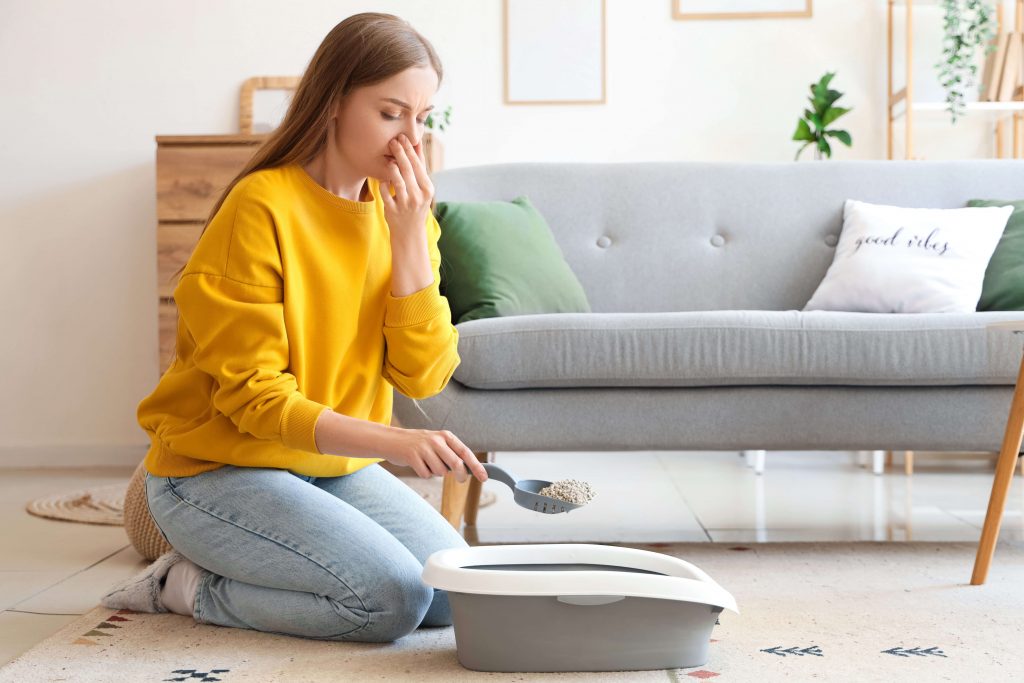
DID YOU KNOW…
… that odours arise when bacteria become active and start breaking down organic substances such as urine and faeces? During the decomposition process, they produce various odour-intensive compounds such as ammonia, hydrogen sulphide and other volatile organic compounds. The growth of these bacteria is fostered by moisture and heat, which accelerate the decomposition process and odour formation even further! Ammonia, which is mainly produced during the decomposition of urine, is one of the main causes of that telltale pungent odour we associate with cat litters. Sulphur compounds, which are produced during the decomposition of proteins, also contribute to foul odours. Our human noses will detect these compounds even in small quantities, and the fumes will prompt a very strong revulsion in us! 👃♨️
Your cat’s litter tray stinks – Here’s how to clean it step by step

In the warm summer months, it’s likely your cat’s litter box will be quicker to start emitting a foul smell than in the cool winter months. This is because warmth and moisture provide the perfect breeding ground for bacteria. To prevent this from happening, it’s important to clean the litter tray thoroughly: first, you should remove all the litter and wash the litter box with hot water and a mild, cat-friendly cleaner. After that, air out the room well and let the litter tray dry completely. As soon as everything is dry again, refill the tray with fresh litter.
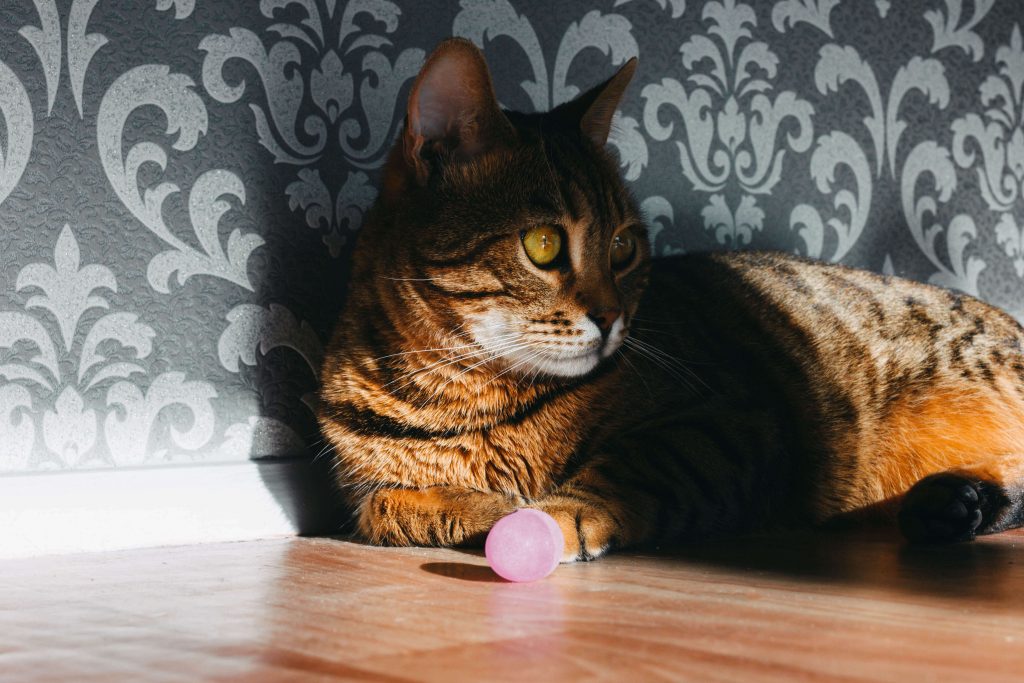
TIP:
In the warmer summer months🌞, you should clean the litter tray a bit more often, as the high temperatures 🌡 accelerate the creation of odours ♨️ in the tray. When you switch out the entire tray on a regular basis, you ensure optimal hygiene and a fresh scent – even on those hot summer days!
Step 1: Empty the litter tray
Bevor Du das Katzenklo reinigst, musst Du die alte Streu entfernen. Dazu wird der gesamte Inhalt der Katzentoilette zunächst in einen festen, Before you clean the litter tray, you’re going to have to remove the old litter. First, pour all the contents of the litter box into a sturdy, sealable trash bag. It’s very important that you dispose of used litter properly. https://www.catsbest.eu/how-to-correctly-dispose-of-cat-litter/. If you’re using litter made of bentonite, calcium quartz sand or silica, you should dispose of it in the regular trash bin, not in the toilet. Why? Because the regular trash bin is for all waste that can’t be separated or recycled, which is what that kind of litter is. In contrast, plant-based litter made from renewable resources can be disposed of in your regular trash but also – if approved of by your local waste management company – in your organic waste bin.
Step 2: Clean your cat’s litter tray with warm water
Once you’ve removed all the litter, it’s time to clean the tray thoroughly using warm water and a mild detergent. The heat of the water will make it easier to loosen dirt and organic deposits. Please don’t use any harsh cleaning agents, because they can irritate your cat’s sensitive nose and paws. A mild, cat-friendly cleaner is perfectly adequate! Take your time and don’t forget to clean the corners thoroughly – those are the spaces where residue tends to collect. Always soak well …!
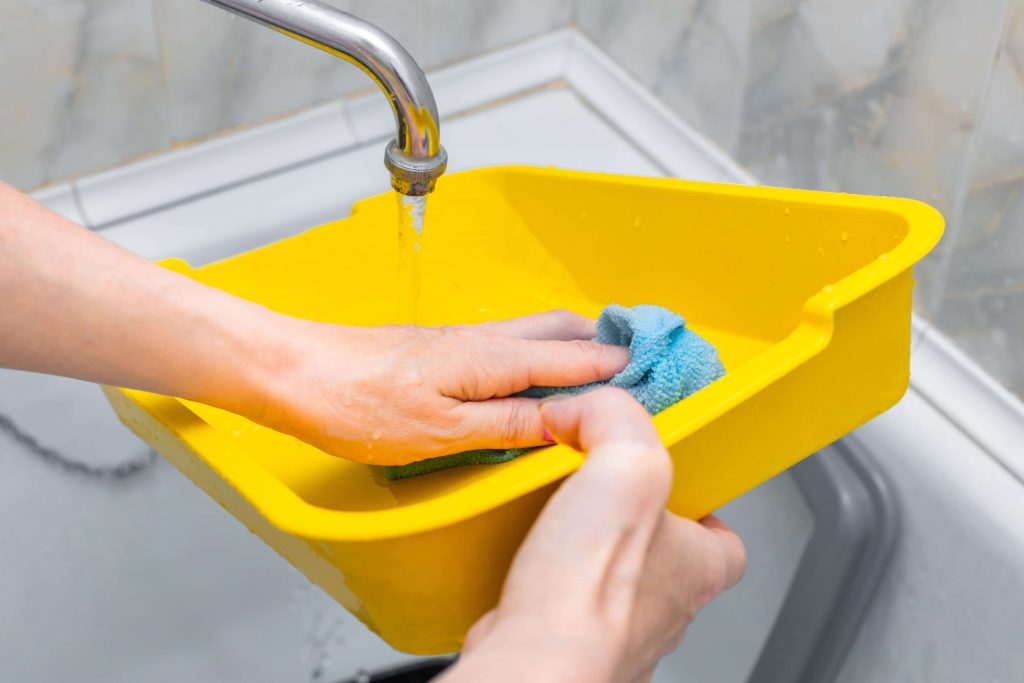
Step 3: Use a mild neutral detergent
A mild neutral detergent is all you need to do a thorough cleaning of the litter tray! This kind of cleaner is perfect because it removes bacteria and residue very effectively without exposing your cat to strong chemicals. It’s best to choose a cleaner that doesn’t contain any aggressive fragrances or additives; remember, our furry feline friends have very sensitive noses! After washing your cat’s litter tray, it’s important to rinse it out thoroughly so that no residues remain. This will keep the tray free of bacteria and germs – and allow your kitty cat to feel great!
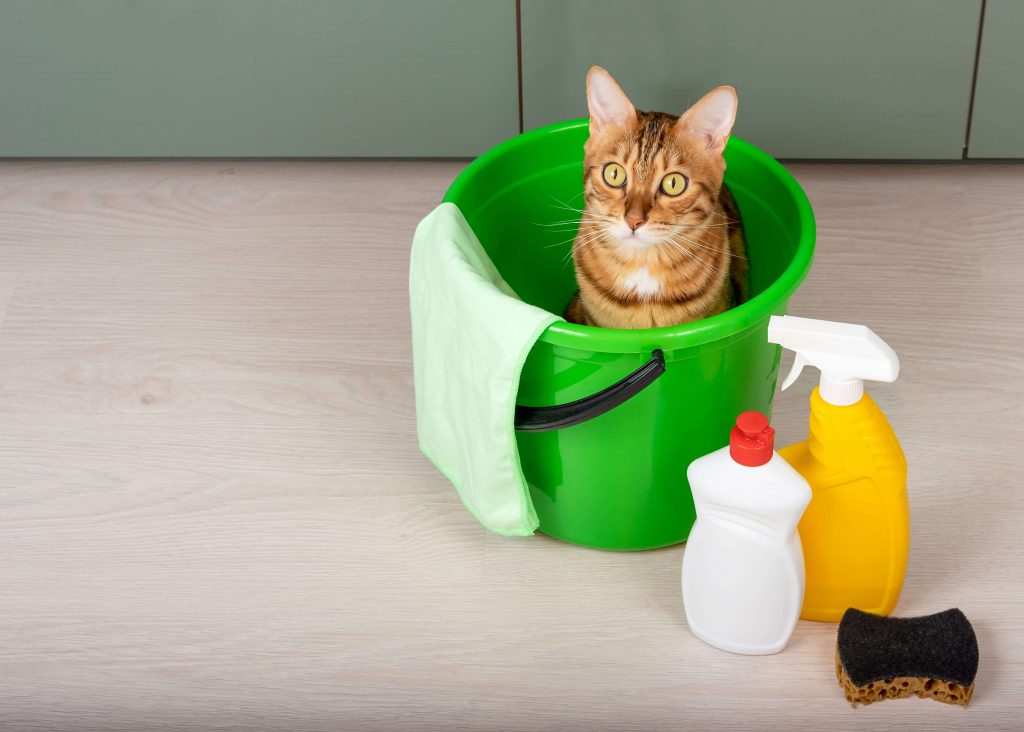
Step 4: Allow the litter tray to dry thoroughly
“Good things take time” is the old adage, and this is exactly what you should have in mind after you’ve cleaned your cat’s litter tray. Before refilling the tray with fresh litter, it’s important to let it dry completely! Moisture is an ideal breeding ground for bacteria, so it’s important that the litter tray remains dry and clean. You can leave the tray to air dry or wipe it with a clean cloth. Either way is fine. Both approaches help you avoid unpleasant odours and create an inviting, “quiet place” for your cat!
Avoid making the following mistakes when cleaning your cat’s litter tray!

Cats and their owners want the litter tray to be clean at all times. Unfortunately, mistakes are sometimes made when cleaning, and these mistakes can potentially cause unpleasant odours and ultimately impact the well-being of our furry friends. Here are some common litter-related mistakes along with some key tips on how to avoid making them:
Not cleaning the litter tray often enough
One common mistake is not cleaning your cat’s litter tray often enough. Our kitties are very sensitive animals and will avoid dirty toilets when their instincts tell them they can’t feel comfortable there. If you had to use a dirty toilet every day, you’d be disgusted too, right? Your feline friend feels the exact same way! If you don’t clean the litter tray often enough, this might lead your cat to boycott using it and maybe even to urinate outside the litter tray. Another thing that happens when you don’t clean your cat’s litter often enough is that bacteria and unpleasant odours multiply. This is why it’s so important to remove faeces and urine several times a day!
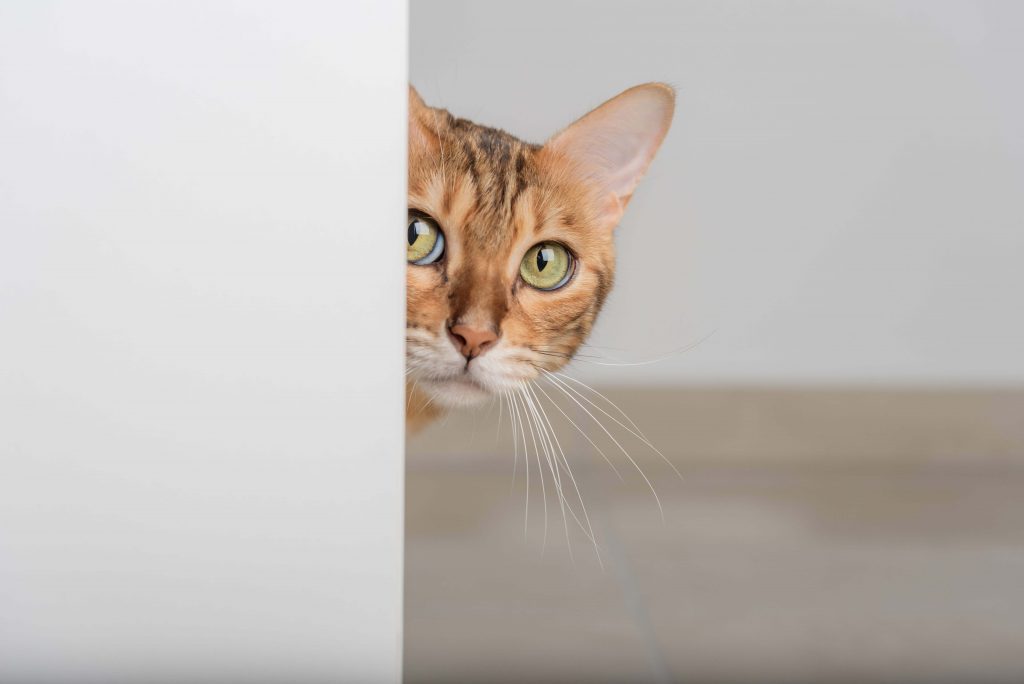
Using the wrong amount of cat litter
It’s the quantity that counts! The litter tray should be filled with the right amount of cat litter. Why? If you use too little litter, the urine won’t be absorbed properly. Unfortunately, this can quickly lead to unpleasant odours. Does that mean you should put a lot of litter in the tray? Not necessarily! If you put too much cat litter in the tray, you’ll be asking your cat to plough through mountains; plus it’s not so practical, because it’ll make it harder for you to locate and remove the dirty litter and clumps.
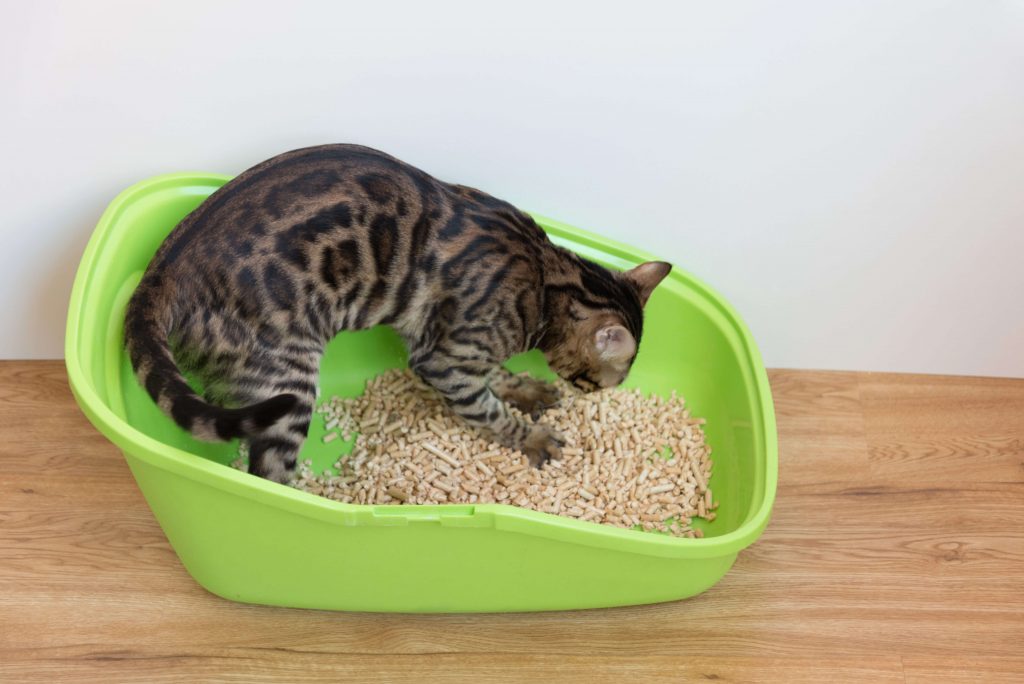
DID YOU KNOW …
… that there are big differences between the various types of cat litter when it comes to the amount you need to put in the tray?
Clumping Bentonite litter should be filled at least 7-10 cm high so that the clumps remain stable and odours are well bound. With silicate litter, a filling height of 3-4 cm is sufficient; unfortunately, unpleasant odours develop if this litter is not changed frequently. A better choice is plant fibre litter, which is economical and high-yield: an average filling height of approx. 5-7 cm is sufficient, as moisture and odours are absorbed very quickly and permanently trapped by the fine fibrils of the fibres – all without any artificial fragrances or additives!
Using the wrong cleaning agent
Our feline friends have very sensitive noses, and this means they’ll immediately be put off by any contact with strong chemical cleaners. In other words, any detergent with an intense scent is not suitable for cleaning the litter tray. Not only will these cleaning agents disturb your cat’s sensitive sense of smell, they’ll also likely irritate the delicate skin of their paws. It’s best to use a mild neutral detergent that cleans thoroughly and leaves no residue. This will keep your cat happy and their litter tray in a hygienic condition!
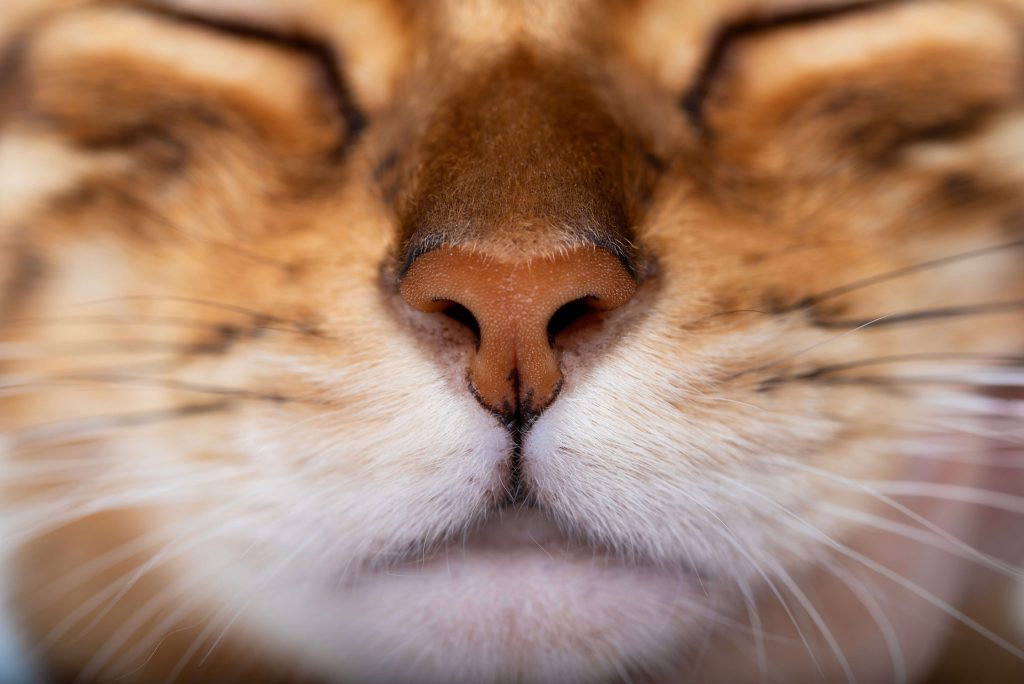

TIP: Don’t forget to also clean the scoopers you use to clean the tray!
When is the right time to get rid of the entire litter tray?
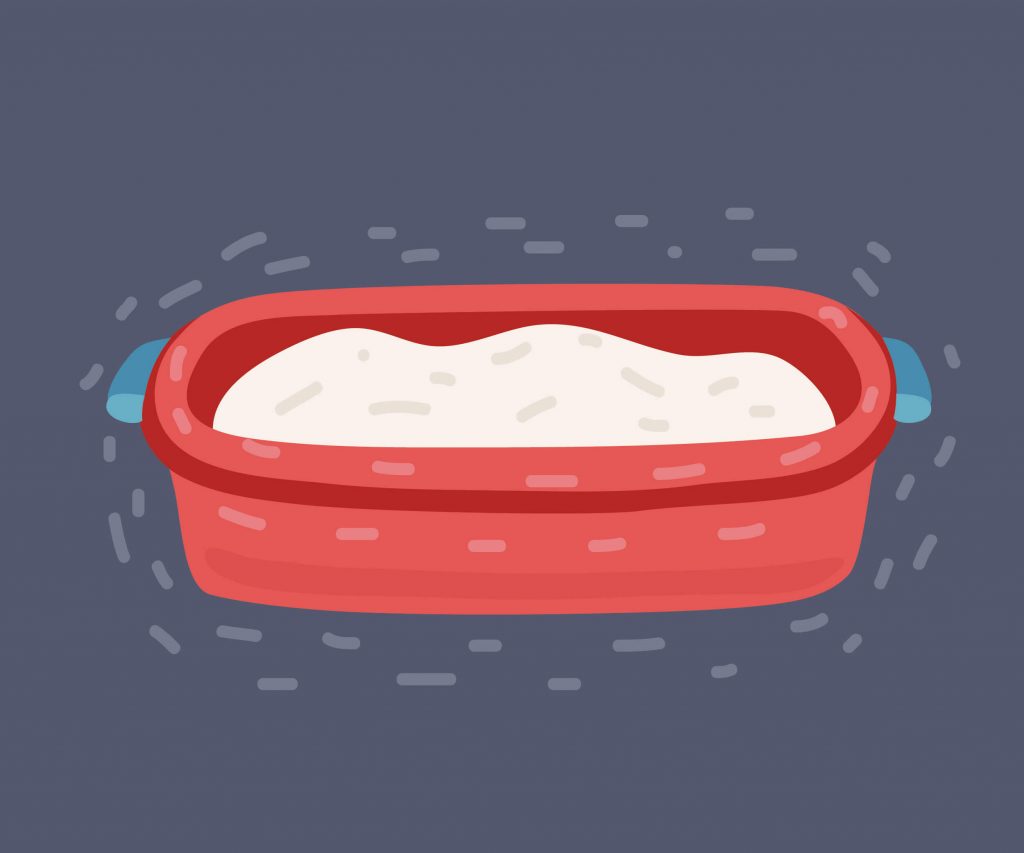
A good litter tray will be a trusty companion to you and your cat for a while, but even the best tray will eventually wear out! In other words, even if you’ve been taking excellent care of your litter, when you start to notice that cracks have formed in the material or there’s an odour you just can’t get rid of … it’s time to get a new one. Scratch marks can also damage the tray and make cleaning more difficult. It’s really important that you check once a year whether the litter tray is still in good condition. If you decide to get a brand new and intact litter tray, your cat will be delighted!
Your cat’s litter tray is damaged
Even though small cracks and scratches in the litter tray may seem harmless at first glance, they can unfortunately quickly lead to problems. It’s possible for urine and bacteria to collect in these cracks and this can lead to unpleasant odours no matter how much cleaning you do. If the toilet is cracked or the material is worn out, you’re going to have to replace it. An intact litter tray is not only more hygienic, it also ensures that your feline friend will feel comfortable using it.
Your cat’s litter tray still stinks despite thorough cleaning
We all know how important it is to clean our cats’ litter trays. Unfortunately, unpleasant odours still sometimes occur. This can have various causes: for example, bacteria can settle in the smallest cracks as well as in scratch marks in the tray’s material. Damp litter and a lack of ventilation can also contribute to the odour. Check the litter tray for damage and make sure the litter tray is completely dry before pouring the litter in! If none of this helps, the only remedy is to replace it …
Why should you regularly buy a new litter tray?
Cat litter trays are made of a material that can become damaged over time by constant use and scratching by the cat. Frequent contact with moisture and cleaning agents in particular can cause the plastic to become brittle. This can result in small cracks that fill with bacteria and trap unpleasant odours. In this case, it’s advisable to buy a new litter tray. A new litter tray ⁴ will not only improve hygiene; it will also enhance your own well-being and that of your kitty.
⁴ Source: Vergleich.org (10 Oct.2024): “Katzentoilette Vergleich 2024. Die besten Katzenklos im Vergleich”, online at Katzentoilette Test & Vergleich Top 10, accessed on 11 Oct. 2024
Where should you dispose of you cat’s litter tray?
When the old litter tray has become worn-out, it needs to be disposed of properly. A broken litter tray belongs in the residual waste bin, as hard plastic is not recyclable in most cases. Larger litter trays often don’t fit into the residual waste bin, so it’s best to find out in advance where you can best dispose of it in your neighbourhood. Local recycling centres usually have containers for hard plastic where you can dispose of you old litter tray. When you bring your old tray to one of these centres, they’ll dispose of properly or recycle it.
Frequently asked questions – Cleaning my cat’s litter tray
It’s very important to clean your cat’s litter tray daily. Faeces and damp spots should be removed to minimise bacteria and odours. You should also clean the litter tray thoroughly once a week and replace the used litter with fresh litter. This will keep the tray as bacteria-free as possible, plus your cat will feel comfortable using it.
To clean a litter tray thoroughly, the first thing you have to do is remove the litter. After that, wash the tray with warm water and a mild, cat-friendly cleaning agent. Don’t forget the corners! This is where dirt often accumulates. The litter tray should be completely dry before you add new litter.
Avoid using any harsh or perfumed cleaning products as these can disturb the cat’s sensitive sense of smell. Bleach and any kind of disinfectant that contain chemicals are also not suitable; the residue from these agents can cause skin irritation. It’s much better to use mild, neutral cleaning detergents that can be rinsed off easily afterwards.
It’s best to clean your cat’s litter tray once a day, preferably in the morning or evening when your cat uses it less frequently. This will allow you to minimise odours and bacteria. To keep the tray in a hygienic condition, you should do a thorough washing once a week and change the used cat litter at the same time.
As soon as the litter tray starts to show clear signs of wear and tear, such as cracks or scratches in the plastic, it’s time to start looking for a new one. Why? Those cracks and scratches can harbour bacteria that are difficult to remove. It’s also better to buy a new litter tray if it’s getting harder to keep your old one as clean as it used to be, but also if it won’t stop stinking or it’s damaged in some spots.
The first thing to do is to get in the habit of removing all lumps and damp patches on a daily basis. After that, make sure to wash the entire litter tray once a week thoroughly with warm water and a mild detergent. You should also check for any cracks in the material that might be harbouring the bacteria responsible for unpleasant odours. If you’ve been changing the litter regularly and airing out the rooms at the same time and the smell is still too much, you should consider switching to a more absorbent cat litter and perhaps even buying a new litter tray.
